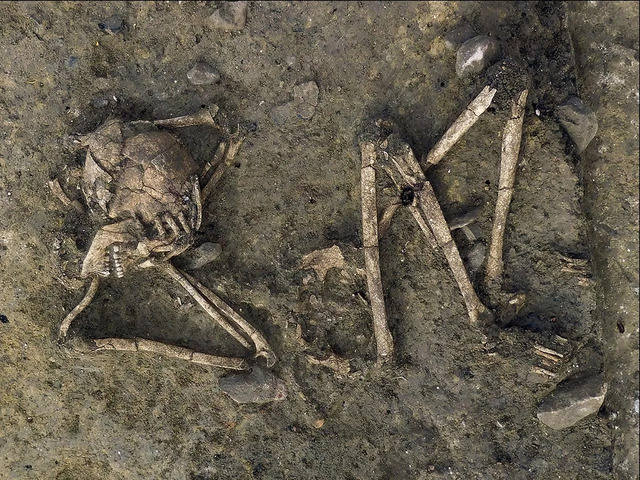In the quiet town of Puisserguier, located in southern France, a groundbreaking archaeological discovery was made in 2017 that reshaped our understanding of Neolithic burial customs. Hidden within a storage pit measuring 2.9 meters in diameter, researchers unearthed the remains of a woman dating back to the Chalcolithic period (approximately 2700-2600 BCE). This burial belonged to the Verazien culture, an ancient civilization that thrived in the regions of Languedoc-Roussillon and Catalonia.

The discovery was remarkable not only for its age but for the meticulous arrangement of the remains, revealing a burial ritual unlike anything previously documented. The woman’s body was carefully positioned, lying on her back with her limbs slightly bent to the left and her arms crossed over her chest. Most notably, her severed head was placed upon her chest, delicately supported by her right hand. This arrangement, which remained undisturbed for over 4,000 years, offered profound insights into the spiritual and cultural beliefs of the Verazien people.
Through advanced scientific techniques such as paleogenetic testing and pelvic morphology analysis, archaeologists confirmed the skeleton’s sex and established an accurate timeline for the burial. The undisturbed and deliberate positioning of the remains strongly suggested that this burial was no random occurrence or act of violence but rather a carefully executed ritual of great significance. This raises compelling questions about the spiritual and symbolic meaning embedded in this ancient practice.
Decapitation and dismemberment have been documented in various Neolithic sites across Europe, but the burial at Puisserguier stands apart in its uniqueness. In many cases, such practices have been associated with violence, exclusion, or punishment. However, this burial exhibited no evidence of such motivations. Instead, the preservation of the connection between the skull, mandible, and hand indicated that the arrangement was made shortly after death, emphasizing intentionality and care. The intricate nature of this burial challenges traditional interpretations of decapitation in Neolithic societies, suggesting it was not merely an act of brutality but rather a ritual imbued with cultural and spiritual significance.
The findings have led researchers to explore the possible symbolic meanings behind the burial arrangement within the context of the Verazien culture. The positioning of the severed head, combined with the apparent reverence shown in the burial, suggests that the act may have represented a complex spiritual belief system. It is possible that the deceased woman held a significant role within her community, and her burial reflected her continued importance in guiding or protecting the living even after death. Such interpretations offer a fascinating glimpse into the worldview of the Verazien people and their understanding of life, death, and the afterlife.
While the exact purpose and meaning of the burial remain speculative, its uniqueness provides a valuable window into the cultural practices and belief systems of prehistoric communities. The burial challenges longstanding assumptions about Neolithic funerary practices, highlighting the diversity and sophistication of these ancient societies. The discovery also underscores the intricate ways in which prehistoric cultures expressed their reverence for the deceased and their connection to the spiritual realm.
The significance of this discovery has not gone unnoticed in the archaeological community. Researchers have employed advanced technologies, such as 3D modeling and isotopic analysis, to further investigate the life and death of this woman. These methods may reveal additional details about her diet, geographic origin, and even her social status within the Verazien culture. As ongoing studies continue to shed light on this extraordinary find, the burial at Puisserguier remains a source of intrigue and inspiration for archaeologists and historians alike.
Beyond its academic implications, this discovery serves as a poignant reminder of the enduring human quest to understand the mysteries of life and death. The intricate care and planning evident in the burial arrangement reflect a deep respect for the deceased and a belief in their continued presence and influence. This echoes the universal human desire to honor and remember those who have passed, connecting us to our ancient ancestors in profound and meaningful ways.
The Puisserguier burial also invites broader discussions about the ways in which ancient societies conceptualized mortality and spirituality. Unlike modern burial practices, which often emphasize uniformity and simplicity, this Neolithic burial illustrates a rich tapestry of cultural expression and individuality. It challenges us to reconsider our assumptions about the past, encouraging a more nuanced and empathetic understanding of prehistoric cultures.
As research progresses, the Puisserguier burial is likely to yield even more insights into the Verazien people and their way of life. Each new discovery adds another layer to our understanding, not only of this particular culture but of the shared human experience across millennia. The burial stands as a testament to the complexity and sophistication of Neolithic societies, reminding us that there is still much to learn about our collective history.
In conclusion, the discovery at Puisserguier represents a groundbreaking achievement in the field of archaeology, offering a rare glimpse into the rituals and beliefs of the Verazien culture. The meticulous arrangement of the burial, combined with its age and context, challenges traditional interpretations of Neolithic funerary practices and highlights the spiritual depth of ancient societies. As researchers continue to explore the mysteries surrounding this extraordinary find, the burial at Puisserguier will undoubtedly remain a cornerstone of our understanding of life and death in the ancient world. This remarkable discovery not only deepens our appreciation for the past but also inspires us to continue seeking answers to the enduring questions of human existence.





